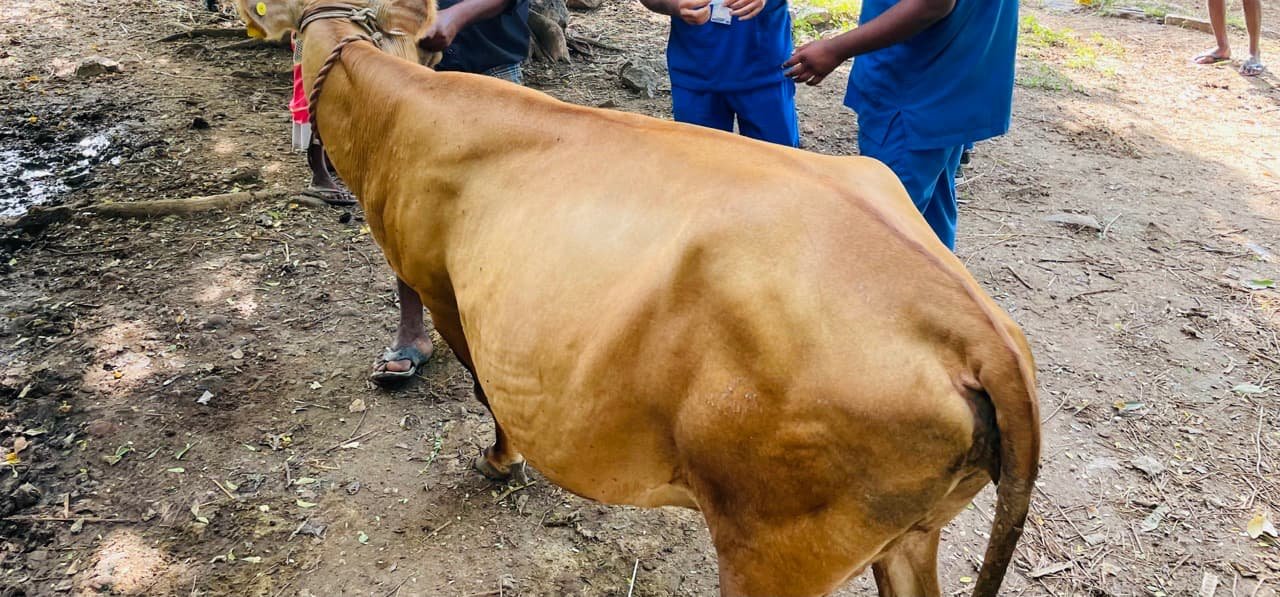TABLE OF CONTENTS
Transition Period and its Management in Dairy Cows
Transition period and its management in dairy cows refers to the critical phase around calving when cows undergo physiological and metabolic changes as they transition from late pregnancy to lactation. Proper management during this period is crucial for ensuring the health and productivity of the cow and optimizing milk production.
The transition period is the last three weeks of pregnancy (close-up dry period) and the first two weeks of lactation (early fresh period). It is the critical period in the cow’s preparation for lactation. Minimising the incidence of metabolic or health disorders at this time will help the cow achieve maximum milk production.

Important Elements of an Effective Transition Period
Important elements of an effective transition period are:
- Maximise dry matter (DM) intake in readiness for peak production.
- Adapt rumen microbes by feeding similar feed sources to the milkers’ diet.
- Avoid feeding high levels of calcium and buffers (containing sodium and potassium) in the close-up diet before calving, but reintroduce them in the early fresh ration.
- Introduce grain-based concentrates slowly (increase by 1 kg every two days until target intake levels are reached) to reduce the risk of acidosis.
Feeding Close-up Dry Cows (three weeks before calving)
Lead feed with grain-based concentrates (1–3 kg/ cow/day) three weeks before calving for adult cows and four weeks before calving for first calf heifers. Lead feeding will help to:
- Maximise dry matter intake.
- Prepare the rumen for higher concentration levels in the milking diet.
- Prevent metabolic disorders such as milk fever, ketosis, and grass tetany.
Feed close-up dry cows similar feed types (concentrates and forages) to the milkers’ diet to adapt the rumen microbes to the lactating diet and improve DM intake at calving.
Dry matter intake declines rapidly 1–2 days before calving until 2–3 days after calving. Energy intake at this time may be reduced by 35%. Providing a diet that encourages intake during this period will minimise the loss of body condition, help prevent ketosis, and maximise peak milk yield.
Feed anionic salts as part of the lead feeding programme if milk fever and retained placentas are a problem.
Anionic salts provide anions (chloride and sulphate) to counteract the cations (potassium and sodium) in the diet. The correct balance will lower body pH, stimulate calcium release from the bones and calcium absorption from the gut, and help prevent milk fever and retained placenta at calving.
Anionic slats are quite unpalatable and may further depress DM and energy intake.
To determine whether anionic salts are working, test the urine with pH test strips.
Ensure Adequate Mineral and Vitamin Levels in the Diet
- Calcium: 0.50 to 0.60% of the diet DM.
- Phosphorous: 0.30% of the diet is DM. Low P intake can increase the risk of milk fever, downer cow syndrome, retained placentas, and anoestrus after calving.
- Magnesium: 0.40% of the diet DM.
- Potassium: 0.65% but 6 on a 1–8 scale) have a higher risk of displaced abomasum and ketosis, so avoid a lower dry matter intake for these cows at calving.
- Sodium: 0.10% of the diet DM or limit salt intake to 30 g/cow/day to minimize oedema (build-up of fluid) in the naval and udder area.
- Selenium: 0.3 ppm in the total diet to reduce the incidence of retained placenta’s.
- Vitamin E: 1500 IU/day. Deficiency of vitamin E can lead to reduced disease resistance, increased calving disorders and potential vitamin deficiency for the newborn calf in the colostrum.
- Feeding 3–12 grams of niacin (vitamin B3) per day may reduce the risk of ketosis at calving.
- Cows dried off in high body condition (>6 on a 1–8 scale) have a higher risk of displaced abomasums and ketosis, so avoid a lower dry matter intake for these cows at calving.
Feeding Early-fresh Cows (Cows up to Two Weeks After Calving)
In this early fresh period, cows go into a negative energy balance as their energy intake is lower than the energy required. Their natural tendency is to produce milk from their body reserves until intake catches up to energy demand. So calve cows in adequate body condition (5.0–5.5 out of 8) and do not allow the cows to utilise more than 0.75 of a condition score up to peak lactation.
- Provide a balanced diet to achieve maximum DM intake as soon as possible after calving. This will help reduce the loss in body condition.
- Increase the amount of concentrate gradually (increase by 1 kg every two days) up to its highest level to reduce the risk of acidosis. Ensure fresh cows are chewing their cud when resting, which is a sign of a healthy rumen.
- As each fresh cow enters the herd, be alert for signs of potential metabolic diseases such as milk fever, acidosis, and ketosis. Late detection can result in long-term production effects and even death.
- Include buffers such as sodium bicarbonate to help prevent acidosis.
| Common Metabolic Disease | Dietary Prevention |
|---|---|
| Milk Fever | Supplementation of calcium gel: 3 doses, each 300 g. Feeding negative Dietary Cation Anion Diets (DCAD) in the late gestation period and high DCAD in early lactation, maintaining a proper Ca and P (2:1) ration in the diet, and prepartum administration of vitamin D. |
| Udder Edema | Excess feeding of Na and K should be avoided. Supplementation of Vitamin E at 1000 IU/day during early lactation is effective in preventing udder edema. |
| Retention of Foetal Membrane | Daily supplementation of 100,000 IU of vitamin A and 400 IU of vitamin E with 3 mg/day of selenium or injections of selenium and vitamin E (twice: 30 and 15 days prior to calving). Further, antioxidant supplementation during the dry period can prevent the condition. |
| Fatty Liver and Ketosis | Starvation of the pregnant animal should be avoided. Supplementation of Niacin at 3 to 12 g/day reduces the NEFA mobilisation from adipose tissues. Intravenous administration of glucose may decrease blood ketones. Oral drenching of propylene glycol and monensin hydrochloride at 2.5 mg/day and salts of propionic acid may be effective in lowering the blood ketones. |
| Ruminal Acidosis | Provide a ration containing more than 32% NDF, with greater than 80% being from long forage, and avoid sudden dietary shifts. Use neutralising agents such as sodium carbonate, potassium carbonate, magnesium oxide, sodium hydroxide, and calcium hydroxide at 2 to 4%; ionophore rumen modifiers like monensin, lasalocid, narasin, and salinomycin; yeast culture; Virginiamycin; and tylosin. |
| Displacement of Abomasum | Overfeeding of cows should be avoided during the dry period. The diet should constitute about 50% forage and feed long and/or coarsely chopped good-quality forage during the dry period and early lactation. Minimise stress due to other periparturient diseases like milk fever and ketosis. |
The transition period and its management in dairy cows are very important, as the above-listed diseases may be a huge economic loss to the client.

